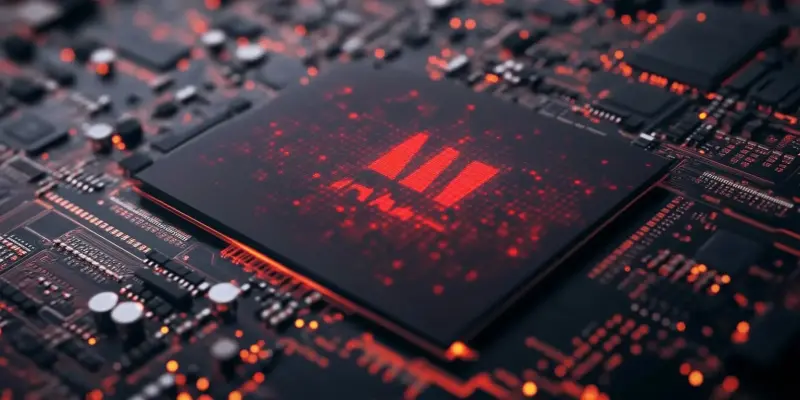AMD, a company noted for its robust hardware, notably the MI300X AI chips, faces a significant challenge that undermines its potential to compete effectively with Nvidia in the AI chip market. Despite having hardware that surpasses Nvidia’s #00 and ##00 in several specifications, AMD’s struggle with software optimization presents a substantial obstacle. This issue has been highlighted by multiple sources, revealing that AMD’s software ecosystem requires constant attention from engineers to address bugs and issues, contrasting sharply with Nvidia’s more seamless integration.
The Challenges with Software Ecosystem
Persistent Software Bugs and Engineer Intervention
Over five months of rigorous testing conducted by SemiAnalysis revealed ongoing issues with AMD’s software that made it difficult to utilize effectively. Unlike Nvidia’s hardware and software, which are known for their smooth operation without needing additional support, AMD’s ecosystem required continuous intervention from their engineers. This persistent need for intervention primarily involved fixing bugs that affected the performance and stability of the MI300X chips. The situation underscores a stark contrast between how AMD and Nvidia manage their software, with AMD’s challenges revealing deeper systemic issues within their development and quality assurance processes.
Issues Faced by Largest Cloud Provider
Tensorwave, AMD’s largest cloud provider, experienced these software struggles firsthand and had to give AMD engineers remote access to its MI300X chips for debugging purposes. This scenario highlights a broader problem where AMD’s software integration, especially with widely-used tools like PyTorch, and scalability across multiple chips fall significantly short when compared to Nvidia’s well-established CUDA ecosystem. The requirement for remote intervention indicates that AMD’s software is not yet ready for seamless, large-scale deployment, a critical factor in the competitive AI chip market. This reliance on constant engineering support could be a considerable deterrent for potential customers seeking robust, low-maintenance solutions.
Comparisons and Adaptations
Leveraging Nvidia’s Libraries
SemiAnalysis noted that many of AMD’s AI libraries are essentially forks of Nvidia’s, leading to suboptimal outcomes and compatibility issues. This dependence on Nvidia’s developed technology is symptomatic of AMD’s challenges. By relying on modified versions of Nvidia’s libraries, AMD introduces additional layers of complexity and potential incompatibilities. These problems stem from AMD’s weaker quality assurance culture, which fails to ensure that software performs optimally out-of-the-box. The broader implication is that AMD’s current approach cannot compete with Nvidia’s well-oiled machine, which offers reliability and efficiency without significant user intervention.
Future Prospects and Developments
Despite these pressing issues, there were promising signs noted in the pre-release BF16 development branches for the MI300X software. Optimistic signals suggest that AMD is making strides towards improvement. However, such advancements may still be insufficient given Nvidia’s rapid pace of development. By the time AMD’s enhancements reach production, Nvidia is likely to have its next-gen Blackwell chips ready, further extending its technological lead. This ongoing struggle underscores Nvidia’s entrenched market position, often referred to as the “CUDA moat,” which AMD has so far been unable to breach.
Recommendations and Future Steps
Recommended Resource Allocation
In light of these challenges, SemiAnalysis recommended that AMD allocate more compute and engineering resources towards enhancing their software ecosystem. This strategy focuses on addressing the critical gaps that have hampered AMD’s competitiveness. AMD’s CEO Lisa Su has reportedly begun implementing changes acknowledging the reported gaps. These efforts indicate a shift in focus towards improving the software stack. However, overcoming the years of neglect in this crucial component remains an uphill battle. Effective resource allocation, bolstered by dedicated efforts to improve the quality assurance and out-of-the-box experience, will be necessary to bridge the existing gap.
The Road Ahead for AMD
AMD, a company known for its strong hardware, especially the MI300X AI chips, is facing a big problem that impacts its ability to compete with Nvidia in the AI chip market effectively. Although AMD’s hardware exceeds Nvidia’s #00 and ##00 in many specifications, the company struggles with software optimization, posing a major hurdle. Multiple sources have highlighted this issue, showing that AMD’s software ecosystem needs constant attention from engineers to fix bugs and problems. This requirement sharply contrasts with Nvidia’s more seamless integration, which doesn’t need as much hands-on effort.
While AMD excels in hardware, its software side seems to lag behind, creating a competitive disadvantage. Engineers constantly work on software improvements to make AMD’s products more reliable. Nvidia, on the other hand, offers a more user-friendly and integrated software experience, providing an edge in the market. This software-related issue indicates that for AMD to fully capitalize on its superior hardware, significant improvements in its software ecosystem are crucial to close the gap with Nvidia’s offerings.

